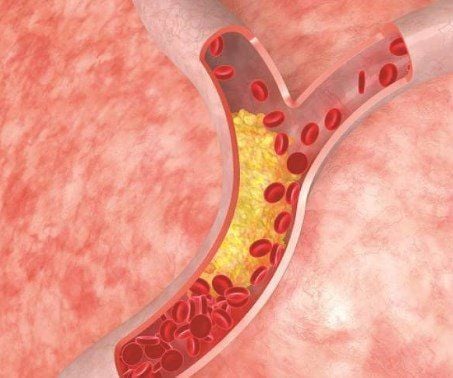This is an automatically translated article.
Arterial bypass surgery is a technique performed to create a new route for blood flow blocked due to hematoma. In particular, axillary-femoral artery bypass surgery is considered an effective treatment for some chronic ischemic diseases of the lower extremities.
1. Arterial bypass surgery
Nowadays, chronic ischemic limb syndrome is a pathological condition that is increasingly occurring in elderly patients with metabolic disorders. This situation is explained by the fact that when the patient has medical conditions such as diabetes, dyslipidemia, high blood pressure, etc., it will result in narrowing and blockage of some arteries that supply blood. for the limbs of the body. Chronic ischemia of the lower extremities usually progresses slowly, from the narrowing of the lumen to the stage of complete occlusion of the blood vessel.
Rối loạn lipid máu lâu ngày có thể gây hẹp và tắc một số động mạch
The main cause of chronic limb ischemia is atherosclerosis. Atherosclerosis often leads to inflammation of the arteries in the extremities, thereby causing ischemia of the extremities, especially the lower extremities, so it is called chronic lower extremity ischemia. Risk factors for chronic lower extremity anemia include smoking, stress, a history of atherosclerosis, obesity, high blood pressure, and problems with lipid metabolism. in the body, people with diabetes, people with hyperuricemia... Some clinical symptoms of chronic anemia in the lower extremities are:
Calf pain, when walking, you often feel pain and tight leg area, so you have to stop and rest before you can continue and keep repeating this condition called claudication, the feeling of leg pain increases gradually, pain late at night or early in the morning, pain even when work and rest, pain unresponsive to analgesics. Pain in the groin, when going up and down the stairs, there is pain. The affected limb is usually blue or purple and feels cooler to the touch than the other limb. During the Buerger maneuver, the patient's skin is pale when the leg is elevated, then pink again when sitting down. Damaged hair and nails in the limbs are slow to grow, even lose hair. The limbs are numb and weak. The pulse in the ankles and feet is very weak, and even pulses cannot be detected in these areas. In the advanced stage, the patient may have ulcers and necrosis in the distal parts of the extremities.

Thiếu máu mãn tính khiến mạch vùng cổ chân và bàn chân rất yếu
Some subclinical techniques to support the diagnosis of chronic lower extremity ischemia are:
Doppler ultrasound of blood vessels to determine the location of atherosclerotic vessels as well as the degree of vascular occlusion. Digital angiography to investigate the condition of the lumen. Echocardiography Coronary angiography Computerized tomography of the aorta Magnetic resonance aortic angiogram After applying clinical and laboratory examination, the treating doctor will determine the extent and location of the injury. damage, from which the appropriate treatment will be selected. In addition to medical treatment with vasodilators, anticoagulants, sympathomimetic inhibitors, etc., bypass surgery is considered the most optimal treatment. Arterial bypass surgery can use materials taken from the patient himself, such as the great saphenous vein, or artificial materials such as artificial blood vessels, to form a bridge over the blockage to allow blood flow to flow. traffic returns.
2. Axillary-femoral artery bypass surgery
In the bypass surgery, chronic ischemic diseases of the lower extremities in stage IIB or after this stage, i.e. when the patient feels calf pain both with activity and at rest or presents with Severe signs such as ulcers in the legs, gangrene in the legs..., and the patient has a blood vessel blockage right at the iliac junction, left and right iliac artery occlusion, along with the general condition of the patient not If suitable for creating a femoral aorta, the best method in these cases is axillary-femoral artery bypass surgery. However, for patients with chronic ischemia of the lower extremities already showing signs of necrosis and amputation, as well as patients with too many other comorbidities, this method should not be applied. axillary-femoral artery bypass surgery.

Bệnh nhân bị đau bắp chân khi vận động hoặc nghỉ ngơi nên tiến hành phẫu thuật
Things to prepare before surgery include:
Explain and inform the patient and family about the method of preparation applied on the patient. Prepare the cardio-thoracic operating room as prescribed. Preparation of material is artificial vessel number 8. Steps to perform axillary-femoral artery bypass surgery are as follows:
Place the patient in a supine position, with both arms closed, with a pillow just below the shoulder. Anesthesia by general endotracheal anesthesia Make a skin incision at the thoracic Delta fissure to expose the axillary artery segment II Next, expose the transverse femoral artery at the junction between the superficial femoral artery and the thoracic artery Deep femoral pulse Establish a tunnel just under the skin starting from the armpit to the thigh, going along the path of the anterior axilla. Use artificial circuit number 8 to enter through the upper tunnel. Create a bridge between the upper part of the axillary artery and the artificial vessel using Prolene 5.0 Thread Create a bridge between the lower part of the 8 artificial vessel and the femoral artery at the junction, possibly with an endothelium removal. Carry out tunneling and continuous suctioning. Close the incision according to the sequence of anatomical layers.

Tiến hành phẫu thuật bắc cầu động mạch nách - đùi
After axillary-femoral artery bypass surgery, the patient should be monitored for a number of issues such as:
Monitor vital signs including pulse, temperature, breathing rate, blood pressure. Bleeding after surgery, possibly caused by the catheter, if after a period of time the bleeding cannot be stopped, it is necessary to open the incision to check If there is a hematoma in the tunnel, it is necessary to use anticoagulants for the patient with a bandage. effective compression and drainage. If the patient has anemia, manifested by symptoms of dizziness, pale skin, low body temperature ... it is necessary to notify the treating doctor immediately to check if the bridge between the axillary artery and the artery is Is the thigh congested? Axillary-femoral artery bypass surgery is a surgical treatment applied to some chronic ischemic diseases of the lower extremities caused by atherosclerosis of the lower extremities. This is a modern technique, although invasive in the patient's body, but can help blood flow between the axillary artery and femoral artery, very effective in treating chronic lower extremity ischemia.
Vinmec International General Hospital with a system of modern facilities, medical equipment and a team of experts and doctors with many years of experience in neurological examination and treatment, patients can completely peace of mind for examination and treatment at the Hospital.
To register for examination and treatment at Vinmec International General Hospital, you can contact Vinmec Health System nationwide, or register online HERE.
SEE MORE
Treatment of coronary stenosis with aortic - coronary bypass surgery at Vinmec Diet after coronary artery disease surgery to avoid coronary re-stenosis Coronary artery disease: Manifestations, causes and ways treatment in Vinmec













